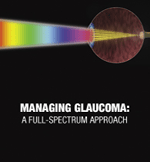Article
Managing glaucoma: a full-spectrum approach
Successful long-term management of glaucoma requires a full spectrum of tools. These may include new technologies and pharmaceutical agents as well as interventional approaches involving laser or surgical therapy.

Successful long-term management of glaucoma requires a full spectrum of tools. These may include new technologies and pharmaceutical agents as well as interventional approaches involving laser or surgical therapy.
One of the important tools for early detection, diagnosis, and management of glaucoma is optic nerve imaging, said Robert Noecker, MD, MBA, vice chairman and director of the glaucoma service at the University of Pittsburgh. Dr. Noecker, who moderated a breakfast CME symposium Saturday at the Venetian Hotel, discussed the Ocular Hypertension Treatment Study (OHTS) and an ancillary study in which HRT images were acquired for patients at seven of the study's 22 initial sites.
"When we looked at relative values, HRT far exceeded any of the other clinical parameters in predicting who would or would not develop glaucoma," Dr. Noecker said. It also appeared that HRT could detect glaucomatous damage up to 8 years prior to any detectable visual field loss or optic disc damage and was effective at identifying individuals at both high and low risk of developing glaucoma.

Presenters (left to right): Andrew G. Iwach, MD; Jason Bacharach, MD; Monte S. Dirks, MD; and Robert J. Noecker, MD, MBA.
"Imaging is increasingly important in diagnosing glaucoma patients earlier and also in following them to see if disease progresses despite our therapy," Dr. Noecker added.
Over the course of a patient's life, more than one strategy may be needed to effectively manage glaucoma. Evidence from a series of clinical trials shows the benefit of achieving and sustaining low target intraocular pressures, and the first line of therapy is usually medical, using a hypotensive lipid, said Monte S. Dirks, MD, clinical assistant professor of ophthalmology, Sanford School of Medicine, University of South Dakota, Rapid City.
If a patient fails to respond to the initial therapy, change it, said Dr. Dirks. Monotherapy is preferable, but another medication may be added if IOP is not successfully controlled with one drug.
Treatment must be individualized on a patient-by-patient basis, and laser trabeculoplasty may be appropriate if a hypotensive lipid and adjunctive therapy together fail to control IOP, Dr. Dirks said. Filtration surgery is also an option.
Lasers have a long history in glaucoma management, and selective laser trabeculoplasty (SLT) advances and refines this technology, said Jason Bacharach, MD, associate clinical professor in ophthalmology, California Pacific Medical Center, San Francisco.
SLT may be an appropriate option for patients with primary open angle glaucoma, pigmentary glaucoma, or pseudoexfoliation glaucoma as a primary or secondary therapy, Dr. Bacharach said. It may be particularly beneficial for patients who have poor compliance or are unable to apply drops or those who are intolerant or unresponsive to medical therapy. In addition, SLT may be tried if the effectiveness of a previous argon laser trabeculoplasty has worn off.
"It's easy to perform technically, rarely do patients complain about pain, and it's really a convenient treatment for noncompliant patients," he added.
SLT can be used as primary, substitute, or supplemental therapy for open-angle glaucoma, said Andrew G. Iwach, MD, associate clinical professor, University of California, San Francisco. Studies are currently evaluating SLT enhancement and repeatability.
With SLT and other treatment modalities, the fundamental objective is to preserve vision during the patient's lifetime, Dr. Bacharach said. When determining the optimal treatment regimen, clinicians should consider the stage of disease, life expectancy, and compliance factors such as the impact on quality of life and recurring costs.
"To me the real litmus test is what would you do to yourself or a family member," Dr. Bacharach added.
The program was jointly sponsored by the New York Eye and Ear Infirmary, which received a financial benefit from ISTA Pharmaceuticals, Lumenis, and Heidelberg Engineering, and by CME2, an independent subsidiary of Advanstar Communications, publisher of Ophthalmology Times.
Newsletter
Don’t miss out—get Ophthalmology Times updates on the latest clinical advancements and expert interviews, straight to your inbox.





